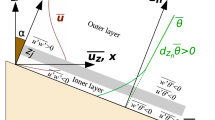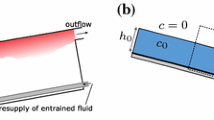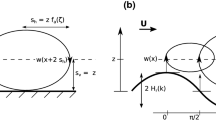Summary
When studying the problem of jetstream formation, the question should be investigated to what extent two-dimensional barotropic momentum transfer might be able to produce jetstream-like currents. Therefore we have performed numerical integrations of the shallow water equations on the sphere with Rossby-Haurwitz wave initial conditions given by ψ=a 2[−A 0sin ϕ+Acosmϕ sin ϕ cosmλ], i.e. a superrotation of the atmosphere with a superposed perturbation. The divergence in our model will produce perturbations about the neutral solution, moreover we have varied systematically the strength of the basic flow, represented byA 0, so as to obtain insight into the flow pattern developing from the initial field under such interaction conditions.
Summing up the main results, we found that for relatively small initial zonal kinetic energy 0≤(A 0/A)2<0.3 the development of the flow pattern is characterized by a northward transport of angular momentum; the convergence of this transport achieves the formation of jetstream-like currents within 2.5–4 days at 32°N, whereby most of the eddy kinetic energy is converted into zonal kinetic energy. If 0.3<(A 0/A)2≤1, a southward transport of angular momentum is observed, the westwind maximum now located at 9°N; the energy conversion\(\bar K_E \to \bar K_z \) is retarded, being completed after 5–6 days.
Similar content being viewed by others
References
Arakawa, A. (1966),Computational design for long-term numerical integration of the equations of fluid motion: Two-dimensional incompressible flow. Part I, Jnl Comput. Phys.1, 119–143.
Arakawa, A.,Design of the UCLA General Circulation Model. Technical Report No. 7, Dept. of Meteor. Univ. of California, Los Angeles, 1972.
Haurwitz, B. (1940),The motion of atmospheric disturbances on a spherical earth, J. mar. Res.3, 254–267.
Hoskins, B. J.,Stability of the Rossby-Haurwitz Wave. U.K. Universities Atmospheric Modelling Group Report, Dept. of Geophysics, Univ. of Reading, 1972.
Hoskins, B. J. (1973),Stability of the Rossby-Haurwitz wave, Quart. J. R. met. Soc.99, 723–745.
Hoskins, B. J., andBretherton, F. P. (1972),Atmospheric frontogenesis models: Mathematical formulation and solution, J. of Atm. Sci. (seit 1962)29, 521–543.
Lorenz, E. N. (1972),Barotropic instability of Rossby wave motion, J. of Atm. Sci.29, 258–264.
Neamten, S. M. (1946),The motion of harmonic waves in the atmosphere. J. Met.3, 53–56.
Philipps, N. A. (1959),Numerical integration of the primitive equations on the hemisphere. Mon. Weath. Rev.87, 333–345.
Rossby, C.-G., andCollaborators (1939),Relation between variations in the intensity of the zonal circulation of the atmosphere and the displacements of the semi-permanent centres of action, J. mar. Res.2, 38–55.
Silbermann, I. (1954),Planetary waves in the atmosphere, J. Met.11, 27–34.
Starr, V. P. (1948),An essay on the general circulation of the earth's atmosphere, J. Met.5, 39–43.
Author information
Authors and Affiliations
Rights and permissions
About this article
Cite this article
Dunst, M., Roeckner, E. A numerical investigation of the connexion between two-dimensional momentum transfer and jetstream formation. PAGEOPH 113, 549–559 (1975). https://doi.org/10.1007/BF01592939
Received:
Issue Date:
DOI: https://doi.org/10.1007/BF01592939




